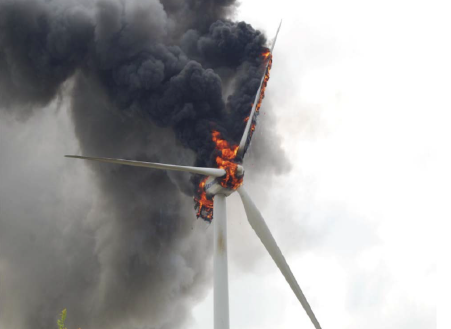Timothy L. Morse, Ph.D., P.E.
Robert W. Whittlesey, Ph.D., CFEI
Exponent, Inc.
Presented at International Symposium on Fire Investigation, 2014
ABSTRACT
Wind turbines and wind farms have become increasingly widespread in the United States. Due to the combination of potential ignition sources (electrical failure, overheating of rotating components, lightning strikes) and multiple fuel loads (fiberglass, bearing grease, gearbox oil, hydraulic oil) wind turbine fires are a regular occurrence. Since wind turbine fires often occur in the nacelle, which can be 200 feet or more above the ground, firefighting options are limited. Wind turbine firefighting efforts are usually directed at preventing the spread of the fire to adjacent land or structures, such as by falling flaming debris, rather than extinguishing the fire. As a result, wind turbine fires often burn until the fuel uptower is exhausted and the fire self-extinguishes. This can present a challenge to a fire origin investigation. Many fire patterns that are observed in a nacelle can provide misleading or conflicting information as they may indicate a fuel load or a source of ventilation, rather than the fire origin. Therefore, attempting to use fire patterns alone to identify the origin is often unsuccessful.
A wind turbine fire origin investigation can be greatly assisted by the large amount of data that is recorded regarding the operation of a wind turbine. Wind turbines are heavily instrumented, with sensors throughout the turbine. Position sensors monitor the blade pitch position, the nacelle yaw position, and the rotational speed of the high speed and low speed shafts. Temperature sensors monitor the gearbox oil temperature, the hydraulic oil temperature, and the brake temperature (as well as other temperatures). The performance of the electrical systems (generator, transformer, inverter) are carefully monitored. Wind turbines also often have vibration sensors in various locations. The data from these sensors are used to control the operation of the turbine through the supervisory control and data acquisition (SCADA) system. This system logs the states of all these sensors as often as once every second and records any alarm states.
A detailed review of this logged data can provide essential guidance to the wind turbine fire investigator. The logged data can indicate which systems or components are having problems prior to the fire, identify any rapid changes in operational state proximate to the time of the fire, or show which systems or components are still functional during the fire and when they lose functionality. A full understanding of the location of the different sensors, and where their communication lines run may also provide indications of the direction of fire spread. Any fire origin that is considered must be consistent with the timing and nature of the SCADA data and SCADA alarms.
